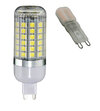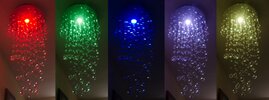I have already had problems with the loss of the fat 65 watt tube, the 58 watt did work to start with although shorter life, but the solar power resulted in the mains voltage reducing, and the 65 watt failed, but this was really down to wire wound ballasts, there was a one point an automatic auto transformer used to correct the voltage to the fluorescent, but this is now considered as snake oil, although when first introduced they did work.
The HF ballast caused problems, and cured some, it tended to fail if the failed tube was not changed quickly, it removed the problem with strobe effect where moving parts looking still or slowly rotating, it increased lumen output, made the tubes last longer, and reduced the power used, and also resulted in them accepting a far larger voltage variation. However the tube rating did not change, so the tube still says 58 watt when in real terms 55 watt, and the lumen still shown as 5000 even when with the HF ballast more like 5500 lumen.
The nasties from the fluorescent are no worse to that from the LED, and unlike the LED the wearing out bits can be changed without renewing the control device. But the big advantage is you know what you are buying.
The LED we know, the control for LED we don't, some produce a strobe effect, some have a flicker which can aggravate some medical conditions, and the problem is we have no idea what we are buying, it seems to be suck it and see, we did know what we were getting with the fluorescent.
The folded tube fluorescent or compact fluorescent was really a failure, giving the fluorescent a bad name, we all saw the 11 watt fluorescent with a BA22d base designed to replace the bulb, and it didn't really work, I know my own house started with two 100 watt tungsten lamps, we fitted chandeliers allowing use to use 6 bulbs, normally 40 or 60 watt, both cases over the original 100 watt but giving both more light and better spread, but the 11 watt CFL looked horrid, so we changed the chandeliers for 5 bulb and went to 8 watt Philips golf CFL which were claimed to last longer, also did dinning room at same time, so 16 x 8 watt bulbs.
Within a year 6 had failed, and dinning room now had larger in physical size 8 watt CFL fitted, much cheaper from I think home base, and by 2 years it was very clear the CFL was more expensive to maintain to the old tungsten bulbs, running cost down, but the bulbs were not lasting.
As this point Lidi did some 1.8 watt LED candle bulbs, and I bought 2 to try, intended to use in table lamps, but used with main lights while we tried to get some more 8 watt CFL. Not sure if colour temperature or actually brighter, but they looked brighter, next batch Lidi had in were 3 watt, so moved to LED, it looked far brighter, however trying to read a book, realised not bright enough, so replaced with 5 watt LED.
So moving from CFL to LED the 8 watt was replaced with 5 watt and gave more light. But this was the CFL not the fluorescent tube, the folded tube I had in my reading lamp, around a foot long, worked very well, as did the 2D lamp. It was only the bulb replacement which were really a failure.
Be it 8 watt or 80 watt the fluorescent tube works well, had the 8 watt in my caravan for years. It was only the compact fluorescent which had a problem.
I suppose the same can be said with LED,
this firm markets 12 and 24 volt LED lamps which work very well and have a really good lumen per watt. But buying LED on the high street is a problem, I found it with G9 lamps, I have posted this picture

many times, the small bulb was a problem, flicker and not switching off, but the covers used with the quartz still fitted, the large bulb worked A1 but the whole chandelier looked very different.
Be it down lights, spot lights, chandeliers or strip lights, we space them and select them with the bulbs/tubes marketed at the time, when we change the bulb/tube to a different type we often also need to change number or types of light.
We fit lights in the home with two things in mind, to see with, and to look good, my landing light I love, I think it really looks good,

but I am under no illusion, as a method of lighting it is rather wasteful of energy, OK way I have wired it I can use either outers or centre independently, so can work out cheaper to run when using just the colour changing centre lamp, and it does look good.

But not really a good method to light the stairs.
In the home only place for the fluorescent tube is garage or kitchen, so it makes little difference to most home owners, but when I changed the 65 watt fluorescent in kitchen for a 22 watt LED, I did not notice the reduction in light, the main difference was it did not last as long, second one did do better, but my son who now owns the house, changed it for I think 16 x GU10 lamps, at 3.5 watt I think, so reduced from 58 watt to 56 watt, was it worth it for light output and spread, likely not, did it look better, yes it did.
So really looking at commercial use, the
MANWEB building in Chester was totally heated by the fluorescent lights, it got loads of awards, it was so good, today it has been demolished. This may happen to commercial buildings, but with domestic, these
and many like it were build after the second world war as a fast method to rehouse, they were never expected to last long, but they have in many cases been clad and are still in use today.
Different styles were built but the prefab was never intended to be long lived, but councils instead of demolishing the homes, sold them, and if you own a pre-fab home your not likely to demolish it and re-build.
“According to the UCC, you must support products for a minimum of seven years after last customer ship!”
So we should see fluorescent fittings being discontinued 7 years before the tubes are discontinued.
So what does the team think?





